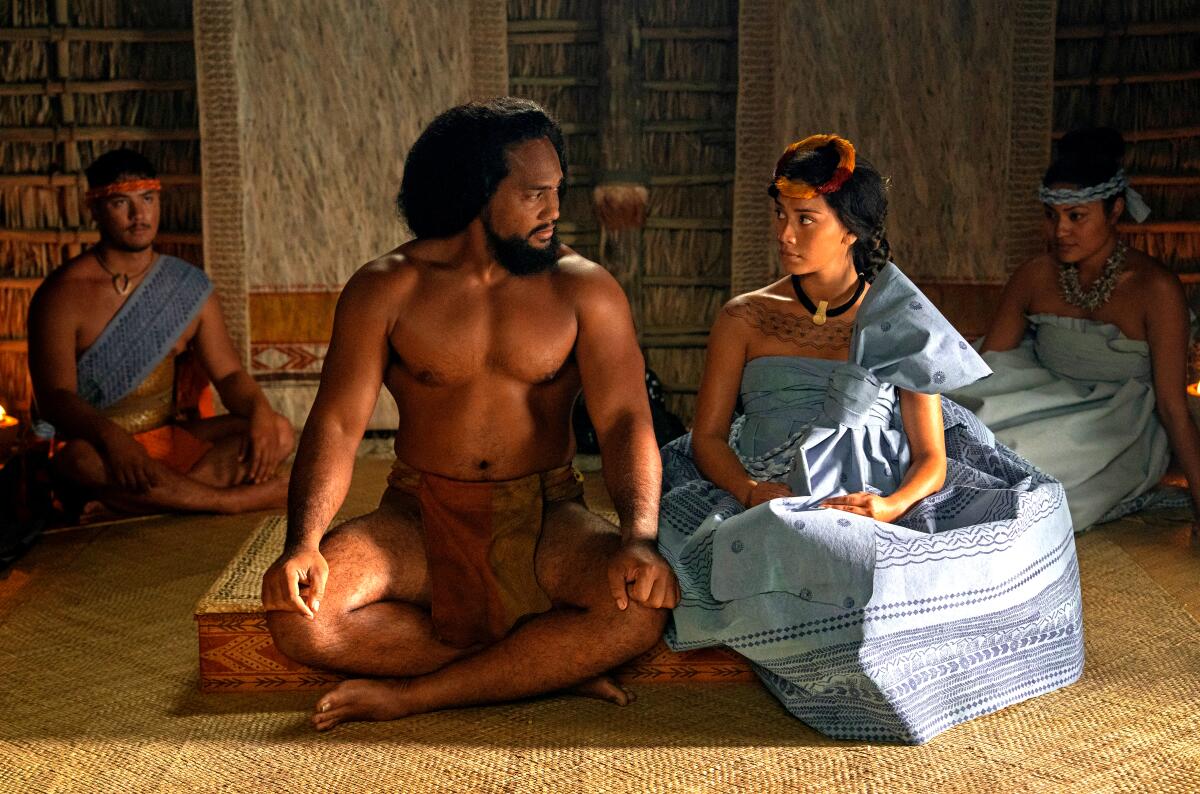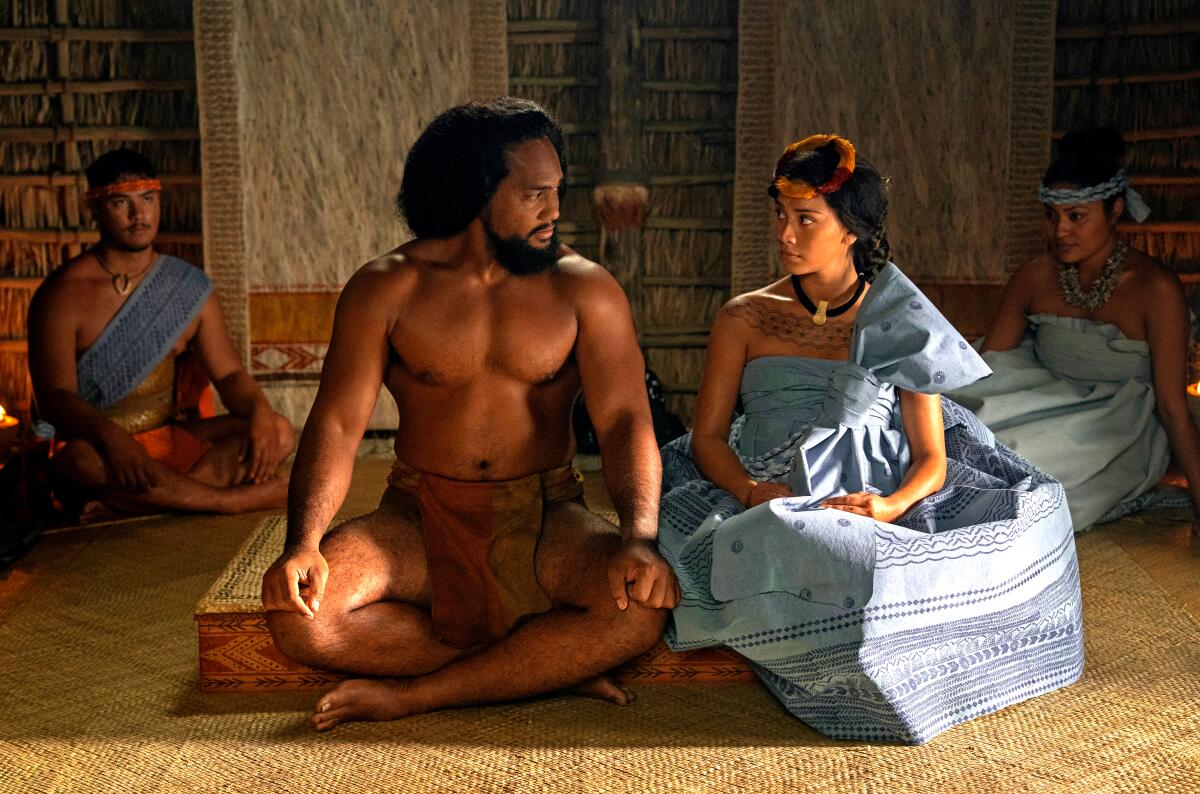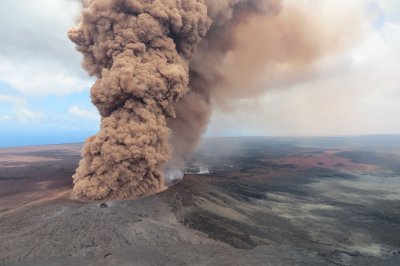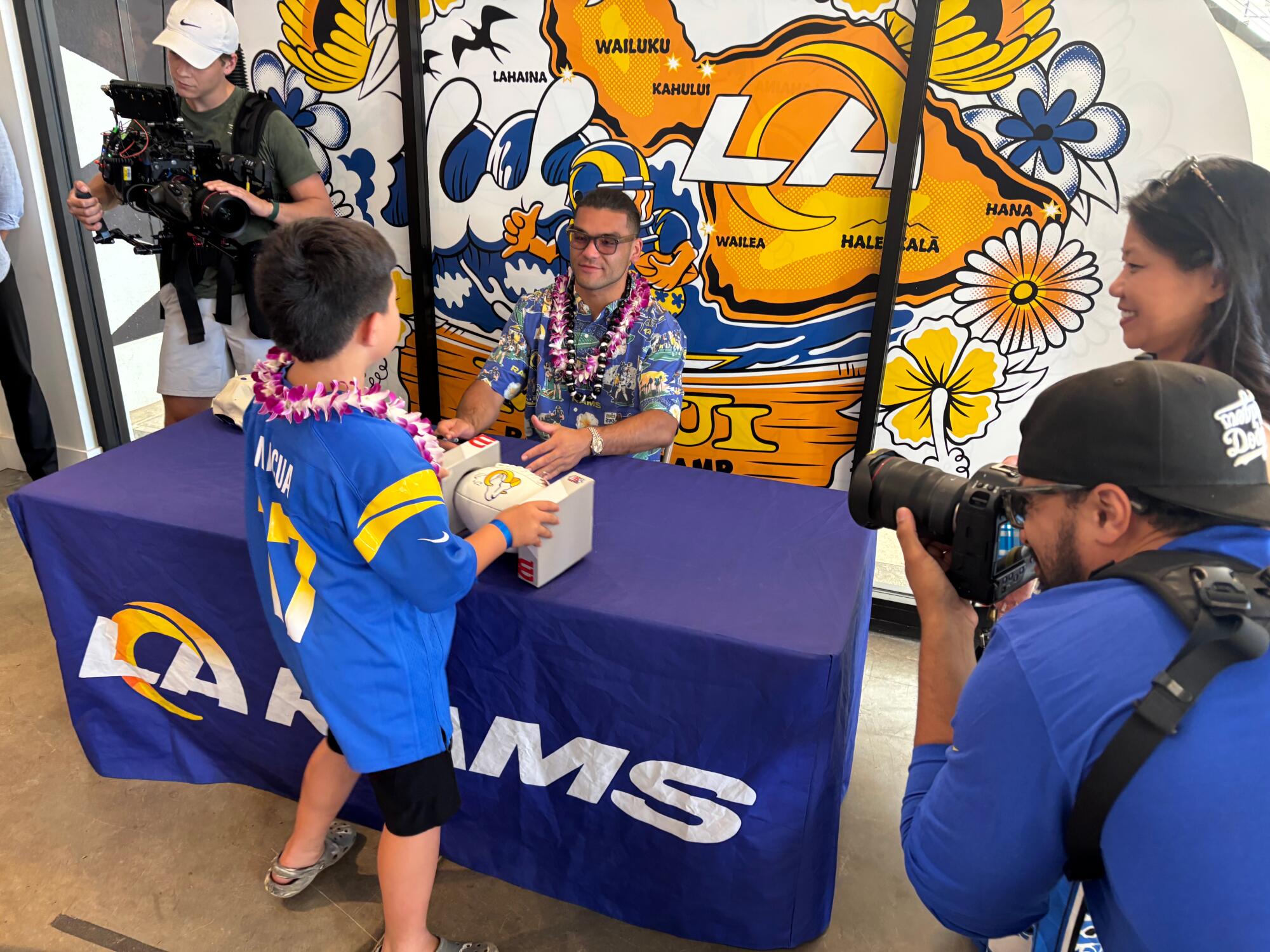‘Chief of War’ review: Jason Momoa centers Hawaiian warrior’s story
A slow-paced, fact-based period drama of war and love in precolonial Hawai’i, “Chief of War,” premiering Friday on Apple TV+, presents co-creator and star Jason Momoa as the late-18th century warrior Ka’iana in a story set at the intersection of the island kingdoms and the arrival of European colonists. It’s clearly a passion project, and like many passion projects, it can go overboard at times, grow overstuffed, not to say oversolemn — though solemnity, to be sure, is appropriate to the history. But the passion shows through, and the stuff is interesting — nothing you see everyday, for sure.
Hawaii, of course, was a cultural touchstone, an obsession among continental Americans, long before it became the 50th state. Ukuleles. Steel guitars. Elvis Presley in “Blue Hawaii” and “Paradise, Hawaiian Style,” not to mention “Aloha from Hawaii via Satellite.” The Brady Bunch traveled there, and so did Dennis the Menace in a comic book I once owned. “Magnum P.I.,” “Hawaii Five-0,” “The White Lotus,” Season 1. Hawaiian Punch (created 1934), which mixed orange, pineapple, passion fruit, guava and papaya flavors, and is still available at a store near you in at least 14 flavors. Tiki bars. Suburban luaus. Walt Disney’s Enchanted Tiki Room, where the birds sing words and the flowers croon, presented by Dole. It goes on and on.
Momoa, who was born in Honolulu, raised in Iowa and returned to the islands for college, slipped into show business by way of “Baywatch Hawaii,” followed by the Oahu-set hotel drama “North Shore.” He played an alien in four seasons of “Stargate Atlantis,” Conan the Barbarian, Aquaman, of course, and twice hosted “Saturday Night Live.” (And recently Ozzy Osbourne’s swan song concert “Back to the Beginning.”) It’s not surprising that he’d want to stretch a little, to step away from genre projects, and represent the roots of his people in a respectful manner. One would call “Chief of War” well-researched, even if one was not at all aware of how much research was done. The ordinary viewer may need to take notes to keep things straight; titles notwithstanding, I wasn’t always certain what island we were on, especially since characters might be living on or aligned with another, and because within an island, various “districts” might be at war, intramurally, as it were. (I did take notes, and I’m still a little confused as to exactly what some of them were after.)
A comparison to “Shogun” is as good as inevitable, given the subtitled dialogue — most of the series is performed in Hawaiian — the encounters with outsiders, the ambitious monarchs and the warring factions. In the latter respects, the series also resembles “Game of Thrones,” where Momoa spent two seasons as chieftain Khal Drogo. And its opening might make you think of “The Lord of the Rings,” as a woman’s voice sets the story (a prophesied king will unite the endless, ending “a cycle of endless war”), introducing the island kingdoms of Kaua’i, Hawai’i, Maui and O’ahu, “separated by cunning chiefs and powerful gods.”
We’re introduced to Ka’iana, a Maui war chief who has left that island, and more to the point, deserted its army, to live a peaceful life on Kaua’i with his two brothers Nahi’ (Siua Ikale’o) and Namake (Te Kohe Tuhaka) and significant others Kupuohi (Te Ao o Hinepehinga) and Heke (Mainei Kinimaka). On the whole, given what follows, one would call this the superior lifestyle, and I would have been happy just to spend a little time in this world, with its plant-based architecture and fashions and cheeky local children getting into Ka’iana’s stuff. But like a retired gunslinger in a western movie, circumstances will not let him rest. (He will, in fact, sling a gun before the season is out.)

Kaina Makua and Luciane Buchanan also stars in “Chief of War.”
(Nicola Dove/Apple TV+)
“A war chief who runs from war — you are a chief of contradictions,” says Kaʻahumanu (Luciane Buchanan), a young Maui woman Ka’iana meets in a cave while he’s on the run, where she’s lying low from her councilor father (Moses Goods), who means to ship her to Hawai’i to marry her to Kamehameha (Kaina Makua), in charge of the “god of war,” a sort of military good-luck charm whose possession will be a major issue, though Kamehameha’s own inclinations bend toward peace. But with crazy villains like King Kahekili (Temuera Morrison) and Keoua (Cliff Curtis), not to mention some rogue white sailors with their own dreams of conquest, that may have to wait.
A contemporary account describes the real-life Ka’iana as “near 6 feet 5 inches in stature, and the muscular form of his limbs was of a Herculean appearance,” which is basically typecasting for Momoa. In many ways “Chief of War” is another superhero role for him, if a more emotionally busy one. He’s the best fighter by miles, can catch a spear in his head, ride a shark (a drugged shark, but still) and whip out a laser stare calculated to make his enemies quake. But he also must grapple with family business, love stuff and getting people to listen to his better ideas.
Circumstances will lead Ka’iana into the ocean and onto a British sailing ship, where he will travel to Alaska and the Spanish East Indies, learn all about guns, which he regards as a potentially useful invention, and to speak English — John Young (Benjamin Hoetjes) a marooned sailor taken into the community, is teaching it back on Hawai’i, and soon many characters are speaking English, even when it doesn’t make any practical sense. And in a story in which “pale-skin” colonists meet and exploit Indigenous populations, white racism necessarily gets a licking — “They do not see you as people,” says Tony (James Udom), a Black man who befriends Ka’iana on his accidental voyage — including an actual licking.
Injecting a strain of anticipatory feminism, Momoa and his collaborator Thomas Paʻa Sibbett have taken care not only to incorporate women into their testosterone-heavy world (including Sisa Grey as a street-smart Hawai’ian expat), but to give them interesting things to do — Kupuohi “was once a chiefess of war,” Heke wants Nahi’ to teach her how to fight — and wise things to say, e.g., “Men train their whole lives to be warriors but they fear being wrong more than they fear death.” (So true.) There are gay characters, too, presented without comment.
The actors are appealing when they’re meant to be, and very much unappealing when they’re meant to be, but they’re all excellent (including the nonprofessional Makua). The pacing can be pokey — elegiac if you prefer — between the big action scenes, which can be disturbingly violent. (It can also be very violent when someone’s just trying to make a point.) Filmed across Hawaii and New Zealand and thoughtfully designed, it’s always a pleasure to look at, notwithstanding some dodgy CGI in the volcano scene. (Yes, there’s a volcano.) There is one red-hued orgy scene (denoting villainy) too many — which is to say, there’s one. The score, by Hans Zimmer and James Everingham, is Hollywood-obvious, and the series as a whole is not immune to corniness — but that is sometimes just another word for love.





